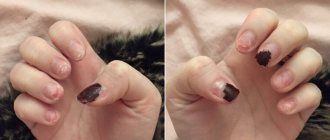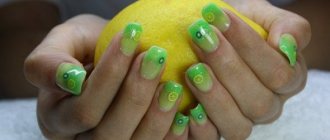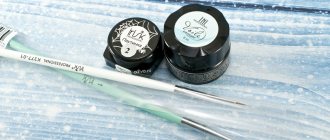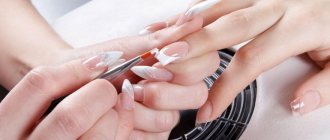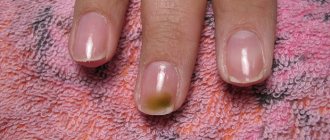Nail restoration plays a huge role for a woman. After all, beautiful and long nails decorate the hand and visually lengthen the fingers.
It is convenient to have neat hands without a lot of time investment. People are often too lazy to restore nails at home, which leads women to get nail extensions.
Thanks to modern extension technologies, weak and brittle nails can be turned into strong and well-groomed ones in a few hours.
But it’s not possible to use gel extensions all the time. After removing the artificial coating, the nails are even more in need of restoration.
Natural nails consist of a stratum corneum of a certain thickness. When removing nails, part of this layer becomes thinner and cannot be restored. The nail will fully strengthen its strength only as it grows. But it is quite possible to help it not collapse and delaminate further.
No matter how strange it may be, home care plays a huge role in nail restoration. Salon treatments will help restore the appearance of your hands, and regular care to restore your nails at home and vitamins will restore their strength and strength.
In this article we will look at all the nuances of nail extensions and help you figure out how to quickly restore your nails after this procedure.
Extended nails
Why is nail restoration required after extensions?
The nail extension procedure is a process in which the length of the nail is artificially increased. The main purpose of nail extensions is to eliminate existing defects of the nail plate, namely:
|
Initially, the procedure for nail extensions arose back in 1960 in the USA , when a dentist tried to “fix” a broken nail with acrylic. The extension technology is based on the polymerization reaction, that is, the hardening of the material under the influence of ultraviolet rays. In the process of artificial nail extensions, additional materials may be used, such as:
|
Modeling nails using forms
The main essence of the procedure is applying a gel to the surface of a natural nail, which tends to harden under ultraviolet light. Before the procedure is carried out, the master must consult the client about safety measures, the nuances of using artificial nails , as well as the properties of the gel. It is worth remembering that the removal of artificial material occurs by sawing off the gel with a special tool (milling cutter) or file. The procedure is not as harmless as many people think, because after laying the gel on the nail, the access of oxygen to natural tissues is partially blocked, which can affect health.
Properties of the gel, is it harmful?
A fairly popular and frequently used material for artificial nail extensions is light-curing gel . Such material tends to harden under the influence of ultraviolet rays, which in small doses do not harm human health . Gel for strengthening and extending nails is a synthetic substance of varying consistency. The main components of the gel are methacrylic acid derivatives and pine needle-based polymers, which harden to form a solid polymer material. Compared to acrylic, gel is a ready-made material for use.
Advantages of the material:
| Disadvantages of gel extensions:
|
Healthy eating as an important element of recovery
Although after nail extensions they have to be restored, girls are still not ready to completely abandon this procedure. Because for a while they get the opportunity to enjoy the beautiful shape of their nails and perfectly selected nail art. Moreover, the hands look well-groomed, so today many girls are required to sign up for a coated manicure.
Of course, any procedure can have negative consequences. And this case is no exception. You have to pay for beauty. But in no case should you refuse restorative therapy after nail extensions. Because this will help quickly eliminate existing problems and improve the appearance of your nails. The most important element of this restorative therapy is proper and balanced nutrition.
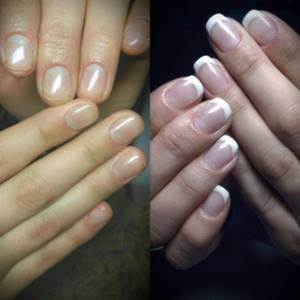
It is necessary to include in your diet those foods that contain large quantities of useful minerals and important vitamins. Such products usually include: eggs, nuts, fish, vegetables, fruits, berries and herbs.
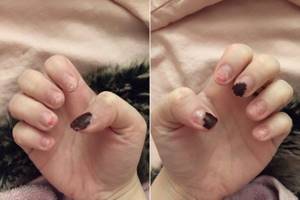
It would not be amiss to introduce beef into the diet. Because it is rich in important microelements and has a reduced calorie content. A healthy diet must be varied. There is no need to create a monotonous menu. Because this will only make the problem worse.
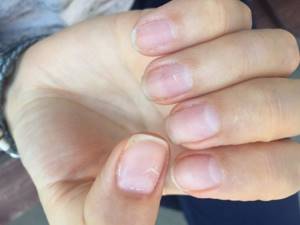
Poor quality extensions
How to distinguish where the master did a high-quality extension, and where the procedure was performed poorly ? Of course, if the basic extension technology is not followed low-grade materials are used the gel layer may from the surface of the natural nail.
nails after poor quality extensions
Peeling of an artificial nail can also occur due to the use of old UV lamps , the serviceability of which must be carefully monitored. This type of lamp most often gradually loses its power and does not completely dry the gel layer.
If the extension is of poor quality, you may notice the appearance of cracks, which most often occur with:
|
It is worth remembering that peeling and the appearance of cracks can also be associated with various chronic diseases , which can appear with prolonged use of medications, with increased sweating and wetness of the hands, as well as with thin natural nails. Poor quality extensions can also be due to the inexperience of the technician. Masters who do not have sufficient qualifications and experience in this field can cause irreparable damage to health , namely:
- introduction of infection;
- injuries, cuts and burns to hands;
- damage to the nail plate.
nails after high-quality nail extensions
It is recommended to choose a specialist based on customer reviews. Even if the cost of services is a little higher compared to amateur masters, you should give preference to an experienced specialist who, in a minimum amount of time, will turn your nails into a real work of art without injury.
Infections after nail extensions
When using non-sterile tools for nail extensions, various types of infections may appear that violate the natural integrity of the natural nail. When the gel or acrylic layer on the nail is damaged, a small gap (air gap) appears, which is an ideal environment for the proliferation of pathogenic fungi and microorganisms. If the damaged nail is not freed from the artificial layer, this can lead to negative consequences.
gribok-nogtej-pod-gelevim-nogtem
It is worth remembering that even after high-quality extensions, the nail plate weakens significantly , which increases the risk of infection with many fungi and infections. If you find a damaged nail, it is recommended to go to a salon or remove the artificial layer yourself using a file. Treatment of fungal infections takes a fairly long period of time, which averages 6 months. If you do not consult a doctor in a timely manner, there is a high probability of losing your own nail and damaging the soft tissues of the hands. Manicurists and doctors advise constantly monitoring changes in the color and structure of the nail plate.
Nail care after extensions
Before carrying out any nail care procedures after artificial extensions, it is advisable to consult with a specialist who will help you choose the right treatment procedures and medications. It is worth remembering that in the first days , when the nail plate is not protected by a gel or acrylic layer, it is necessary to treat your hands with special care .
Initially, it is worth assessing the condition of the nails, the color and structure of the nail plate, only after which comprehensive treatment or prevention is selected. Regardless of the damage, care products should include the following components:
|
The care of damaged nails can be entrusted to either a specialist in a beauty salon or home rehabilitation methods can be used. There are such effective salon procedures for restoring the nail plate, such as:
- Sealing.
During the treatment procedure, the master rubs a specialized nutritional paste into the nail , which consists of components such as beeswax, vitamins and minerals, as well as proteins . After this, the surface of the nail is treated with oil, resulting in a healthy shine. The frequency of the procedure is once every 2-3 weeks. The basic principle of intensive therapy nail sealing is to nourish the nails with beneficial substances that prevent peeling and brittleness.
Nails after restoration with the IBX system
- Application of medicinal preparations and polymerization in the “IBX system” LED lamp.
Innovative technology for strengthening the nail plate was invented in 2014 in the USA. To restore, preparations are applied to the nail, which are heated one by one in an LED lamp . Thanks to this method, it is possible to get rid of brittle nails, splitting and brittleness , cracks and stains, grooves and irregularities.
- Paraffin therapy.
The treatment procedure is carried out in the salon using a special apparatus that melts wax (cosmetic paraffin) with vitamin supplements and maintains the required temperature of the mixture. This therapy has a beneficial effect not only on nails, but also on the skin of the hands, moisturizing and nourishing it . After paraffin therapy, your hands become much more well-groomed and attractive. The cosmetic procedure is quite pleasant and does not cause any pain.
Quick nail restoration at home
It is quite possible to restore nails at home. During the home restoration period, it is not recommended to use varnishes, acetone, gel polishes or decorative jewelry. Basic recommendations for restoring the nail plate after extensions:
- It is worth shortening the length of the nails, because the weak structure of the keratinized part can break quite often and bring a lot of discomfort and sometimes injury. A neatly trimmed edge will look much better than an overgrown and thin nail.
lemon nail restoration
- To strengthen brittle nail plates, it is recommended to lubricate them with natural products , namely freshly squeezed lemon juice or aloe juice . After saturating with vitamins, it is recommended to apply cream or oil to the surface of the nail, which will prevent the evaporation of vitamins from the nail.
- An excellent option would be to improve your diet. It is necessary to consume more vegetables and fruits, dairy products, meat, fish and seafood. Such new habits will only benefit the body.
- Doctors recommend the use of medicated varnishes to strengthen the nail plate . Such drugs can be freely purchased at pharmacies. Before using the medication, it is recommended to study the instructions and method of use in detail.
- Baths with the addition of sage or chamomile are also considered “resuscitation” You need to add medicinal herbs to hot water and leave for a few minutes, then put your hands in the bath. It is not recommended to use boiling water, as it will allow the nutrients to evaporate. Such therapy should be comfortable and not cause burns or skin irritation.
- Doctors and cosmetologists recommend using components for baths at home, such as sea salt, oils (coconut, olive, castor), potato broth or even milk. After the procedure, you need to dry your hands with a towel and lubricate them with a rich cream.
massage using kneads
- Massage of hands and fingers using vitamin creams and oils helps normalize blood flow in soft tissues, so that cells are saturated with nutrients and oxygen . Both home self-massage and massage in a beauty salon have a beneficial effect on cell restoration.
- Oils that should be rubbed into the nail itself and cuticle have a beneficial effect on the weakened nail plate. You can use the following types of oils:
rosemary oil (used to accelerate nail growth and wound healing);
eucalyptus oil (excellently moisturizes and acts as an antiseptic);
grapefruit oil (whitens nails and gives them a healthy shine);
bergamot oil (acts as an antibacterial and antimicrobial agent, and also strengthens the nail plate);
tea tree oil (is a bactericidal agent and is often used as an additional component of creams and baths).
ylang-ylang oil (effectively protects against intense delamination, significantly strengthening the nail); It is worth remembering that with any method of caring for nails after extension of artificial material, it is necessary to observe the systematic application of certain treatment and restoration procedures. Only through constant care can truly positive results be achieved.
Traditional methods
Traditional methods for restoring nails do not work as quickly as salon procedures, but with regular use they are quite effective.
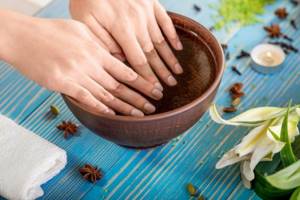
Recommended:
- make baths with the addition of cosmetic oils and apple cider vinegar;
- Baths with gelatin solution strengthen nails well;
- To restore nails, he recommends making wax masks; to do this, just dip your fingers in warm wax;
- It is useful to lubricate your nails with natural oils.
Biogel. Advantages and disadvantages.
Biogel
This type of material is specially designed to strengthen the nail plate. It was invented back in the 80s of the twentieth century. Biogel consists of the following components:
- resins from various trees;
- protein;
- other natural ingredients.
Biogel is gaining more and more popularity due to the painlessness of the procedure and the naturalness of the components that can restore the nail plate, strengthen it and protect it from the negative effects of the external environment. The procedure for applying biogel to nails takes no more than 30 minutes. Natural material has a large number of advantages, namely:
|
Like all other materials, biogel has its drawbacks. Nails with this coating need to be corrected about twice a month, and the cost of the procedure is significantly higher than the cost of applying gel polish to nails. Despite this, biogel does not cause an allergic reaction and is suitable for literally any woman.
Origins of the problem

When performing extensions, regardless of the method used (on tips or on forms), the own plate is covered with a special protective layer. Depending on the technology chosen, it can be gel or acrylic. This layer is airtight, and therefore the plate is deprived of oxygen access. As a result, the new nail may grow back deformed and weak, and the plate from which the gel or acrylic was removed changes color, flakes and becomes thinner.

In addition, in its natural state, the plate has a special protective layer. It produces it in order to prevent the negative effects of the environment. This layer ceases to be produced when wearing extended nails. Also, its formation is significantly complicated by constant painting of nails.

During the extension procedure itself, extremely serious damage is caused to the plates. In particular, when applying the gel, they are cut off with a buff to almost half the thickness. Removal brings even more harm; here the negative impact is present in two forms - chemical and mechanical. Mechanical is applied when the gel layer is cut off, and chemical is applied when it becomes necessary to remove uncut residues. The question of how to restore nails after gel extensions becomes one of the most important for fashionistas after the removal procedure.
https://youtu.be/zIZ4v5sZ1xw


